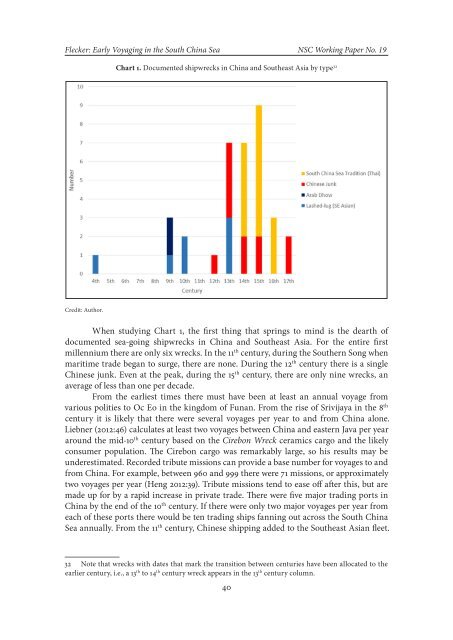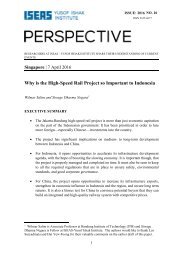Flecker: Early Voyaging in the South China Sea NSC Working Paper No. 19Chart 1. Documented shipwrecks in China and Southeast Asia by type 32Credit: Author.When studying Chart 1, the first thing that springs to mind is the dearth ofdocumented sea-going shipwrecks in China and Southeast Asia. For the entire firstmillennium there are only six wrecks. In the 11 th century, during the Southern Song whenmaritime trade began to surge, there are none. During the 12 th century there is a singleChinese junk. Even at the peak, during the 15 th century, there are only nine wrecks, anaverage of less than one per decade.From the earliest times there must have been at least an annual voyage fromvarious polities to Oc Eo in the kingdom of Funan. From the rise of Srivijaya in the 8 thcentury it is likely that there were several voyages per year to and from China alone.Liebner (2012:46) calculates at least two voyages between China and eastern Java per yeararound the mid-10 th century based on the Cirebon Wreck ceramics cargo and the likelyconsumer population. The Cirebon cargo was remarkably large, so his results may beunderestimated. Recorded tribute missions can provide a base number for voyages to andfrom China. For example, between 960 and 999 there were 71 missions, or approximatelytwo voyages per year (Heng 2012:39). Tribute missions tend to ease off after this, but aremade up for by a rapid increase in private trade. There were five major trading ports inChina by the end of the 10 th century. If there were only two major voyages per year fromeach of these ports there would be ten trading ships fanning out across the South ChinaSea annually. From the 11 th century, Chinese shipping added to the Southeast Asian fleet.32 Note that wrecks with dates that mark the transition between centuries have been allocated to theearlier century, i.e., a 13 th to 14 th century wreck appears in the 13 th century column.40
Flecker: Early Voyaging in the South China Sea NSC Working Paper No. 19By the end of the 11 th century this led to an increase in the trade of high-volume low-valueproducts, such as sandalwood, sappanwood, and ebony, and latter cloves and cardamom(ibid.:50). By the 12 th century, dozens, if not hundreds, of heavily laden ships must havevoyaged throughout the South China Sea and beyond every year. Numbers continued togrow through the centuries. By the 17 th century—the cut-off date for this investigation—the Dutch Day Register, covering Batavia arrivals and departures, mentions Chinese,Japanese, Javanese, Cambodian, Siamese, Malacca, and Manila jonken on an almost dailybasis.Chinese and Arab texts frequently mention the perils. European archives reveal highattrition rates for the fleets that traded with Asia from the 16 th century, when shipbuildingtechnology was well advanced. Storms, pirates, rotten timbers, fire, overloading, and reefsmust have claimed ships every year. The documented shipwrecks are but a fraction ofwhat lies, or lay, out there.Many wrecks have of course been looted without any documentation. Numerouswrecks never come to our attention because they do not contain any cargo of commercialvalue. In fact, most of the wrecks without a ceramics cargo, i.e. almost all those voyagingto China or Vietnam or Thailand, may never come to our attention. Most Asian wrecks areinadvertently discovered when ceramics are hauled up in trawl nets. If the scars evidentin side-scan-sonar images off the east coast of Malaysia are anything to go by, most of theseabed has been trawled, and many times over. Apart from occasionally finding wrecks,trawl nets frequently damage them.But there should still be many shipwrecks awaiting archaeological documentation,assuming the looters, the irresponsible salvors, and the big trawlers do not get there first.The TrendsThe trends are quite evident from Chart 1. In simple terms, Southeast Asian lashed-lugships dominated for a thousand years through to the 13 th century. During the 9 th centuryArab (and probably Indian) ships switched from trading via the Isthmus of Kra to directtrade with China. However, they switched back during the 10 th century. Chinese shipsfirst appear in the South China Sea by the 12 th century, and coexisted with SoutheastAsian vessels during the 13 th century. Unless a design flaw caused an inordinate numberof sinkings, the South China Sea Tradition ships that sprang up in response to variousbans on Chinese overseas trade, would seem to be the prevalent craft from the 14 th tothe 16 th century. From this admittedly simplistic visualisation, it would seem that theSouth China Sea Tradition replaced the Southeast Asian lashed-lug design during the 14 thcentury. 33 However, textual evidence reveals that lashed-lug vessels evolved, with treenailsreplacing internal plank stitching and lashed in frames. Two, and sometimes three layersof hull planking were also attached with treenails. But the quarter rudders were retainedon these vessels, referred to as jongs by the Portuguese. 34 The Chinese continued to tradedirectly with Southeast Asia through to the 17 th century and beyond, with imperial33 It has been assumed that the South China Sea Tradition vessels were constructed in Thailand. Mostwere made predominately from teak. However, a detailed analysis of other timber species found on themany wrecks may shed light on other potential construction sites.34 Manguin 2012:612. The absence of jongs from the archaeological record is an enigma.41








